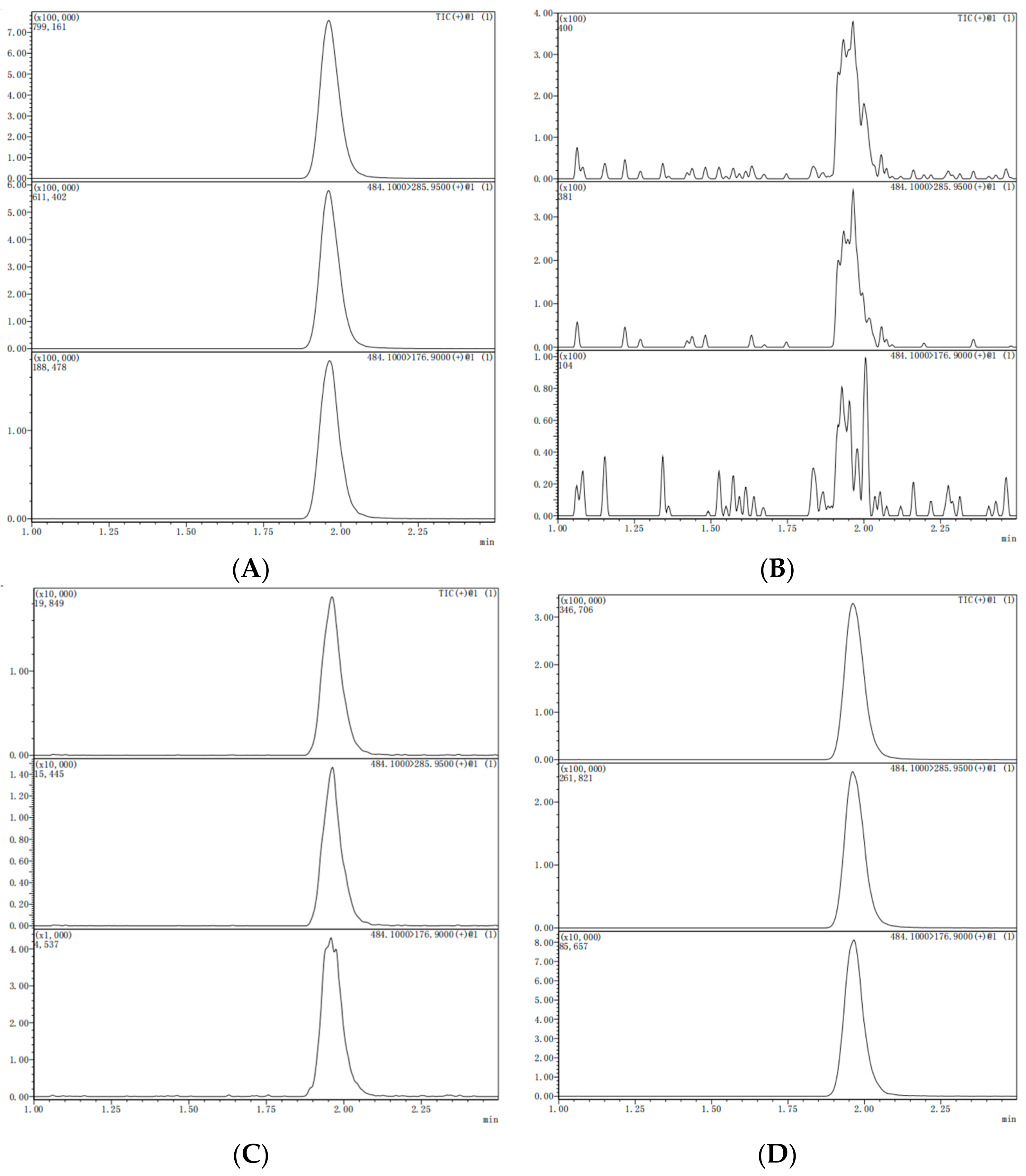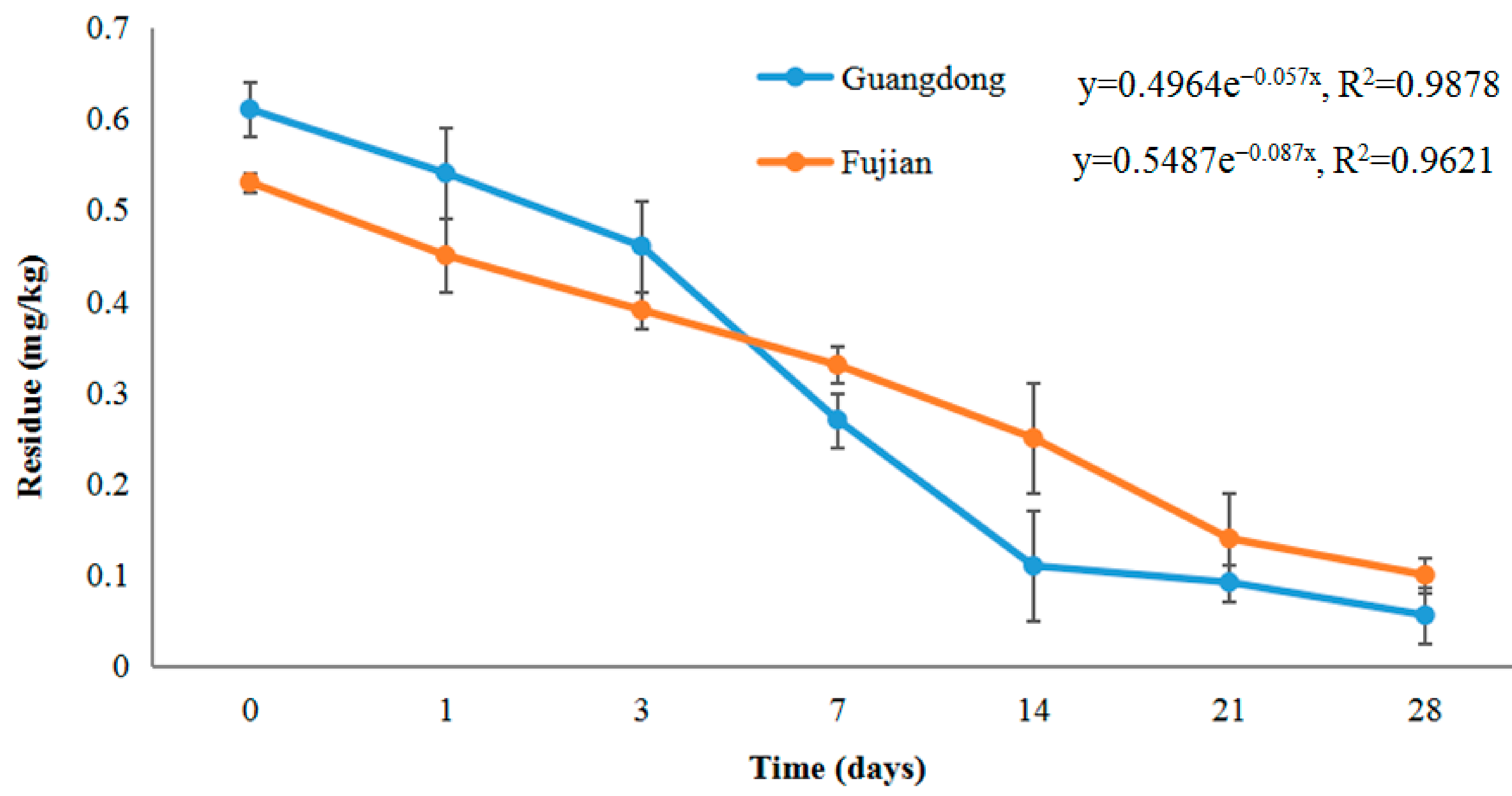Safety Evaluation of Chlorantraniliprole in Lychee Based on Residue and Dietary Risk Assessment
Abstract
:1. Introduction
2. Results and Discussion
2.1. Matrix Effect
2.2. Method Verification
2.3. Dissipation of Chlorantraniliprole in Lychee
2.4. Terminal Residues of Chlorantraniliprole in Lychee
2.5. Risk Assessment
2.6. Discussion
3. Material and Methods
3.1. Chemicals and Reagents
3.2. Field Trials and Sample Preparation
3.3. Extraction and Cleanup Procedures
3.4. Instrumentation and UPLC-MS/MS Analytical Conditions
3.5. Methodological Validation
3.6. Statistical Analysis
4. Conclusions
Author Contributions
Funding
Institutional Review Board Statement
Informed Consent Statement
Data Availability Statement
Conflicts of Interest
Sample Availability:
References
- Qi, W.E.; Chen, H.B.; Li, W.W.; Zhang, H.J. Development situation, trend and suggestions of Chinese litchi industry. Guangdong Agric. Sci. 2016, 43, 173–179. [Google Scholar]
- Hao, J.; Dong, L.H.; Chi, J.W.; Ma, Y.X.; Zhou, Q.Y.; Zhang, R.F.; Bai, Y.J. Health effect of longan and its present situation and prospect of healthy. Mod. Food Sci. Technol. 2021, 37, 340–349. [Google Scholar]
- Li, P.Y.; Huo, L.N.; Su, W.; Lu, R.M.; Deng, C.C.; Liu, L.Q.; Deng, Y.K.; Guo, N.N.; Lu, C.S.; He, C.L. Free radical-scavenging capacity, antioxidant activity and phenolic content of Pouzolzia zeylanica. J. Serbian Chem. Soc. 2011, 76, 709–717. [Google Scholar] [CrossRef]
- Wang, S.W.; Wang, X.N.; Chang, H.; Liu, Y.P.; Sun, H.B. Determination of diamide insecticides and its metabolites residues in litchi using QuEChERS and high-performance liquid chromatography-tandem mass spectrometry. Chin. J. Pestic. Sci. 2022, 24, 395–403. [Google Scholar]
- Wang, S.; Wang, X.; He, Q.; Lin, H.; Chang, H.; Sun, H.; Liu, Y. Simultaneous determination of seven pesticides and metabolite residues in litchi and longan through High-Performance Liquid Chromatography-Tandem Mass spectrometry with modified QuEChERS. Molecules 2022, 27, 5737. [Google Scholar] [CrossRef] [PubMed]
- Yao, Q.; Liang, Z.T.; Chen, B.X. Evidence for the Participation of Chemosensory Proteins in Response to Insecticide Challenge in Conopomorpha sinensis. J. Agric. Food Chem. 2023, 71, 1360–1368. [Google Scholar] [CrossRef]
- Li, T.; Li, J.; Zhao, X.; Xu, Y.Q.; Nie, G.; Wu, C.X. Analysis of the main pests occurred and pesticides registered on litchi in China. Pestic. Sci. Adm. 2022, 43, 7–12. [Google Scholar]
- China Pesticide Information Network. Available online: http://www.chinapesticide.org.cn/hysj/index.jhtml (accessed on 6 August 2023).
- Zheng, X.S.; Lai, T.C.; Shi, L.B.; Lu, W.P. Current situation on application of novel diamide insecticides. Agrochemicals 2012, 51, 554–557, 580. [Google Scholar]
- Han, W.S.; Wang, Y.J.; Gao, J.L.; Wang, Y.J.; Zhao, S. Acute toxicity and sublethal effects of myclobutanil on respiration, flight and detoxification enzymes in Apis cerana cerana. Pestic. Biochem. Physiol. 2018, 147, 133–138. [Google Scholar] [CrossRef]
- Chen, J.; Lu, Z.T.; Li, M.X.; Mao, T.T.; Wang, H.; Li, F.C.; Sun, H.N.; Dai, M.L.; Ye, W.T.; Li, B. The mechanism of sublethal chlorantraniliprole exposure causing silkworm pupation metamorphosis defects. Pest Manag. Sci. 2020, 76, 2838–2845. [Google Scholar] [CrossRef]
- Wang, S.W.; Wang, X.N.; Chang, H.; Liu, Y.P.; Sun, H.B. Simultaneous Determination of Three Pesticides and its Metabolite Residues in Litchi and Longan by High Performance Liquid Chromatography-Tandem Mass Spectrometry with QuEChERS. Mod. Food Sci. Technol. 2022, 38, 286–295. [Google Scholar]
- Chen, H.Y.; Sheng, S.; Zhi, H.; Li, W. Pesticides residues on Goji berry: A characteristic minor crop in China. J. Food Compos. Anal. 2023, 120, 105342. [Google Scholar] [CrossRef]
- Wu, D.Y.; Pan, J. Simultaneous determination of chlorantraniliprole and other five pesticide residues in vegetables by solid phase extraction high performance liquid chromatography. Zhejiang Agric. Sci. 2021, 62, 129–132. [Google Scholar]
- Sun, C.P.; Xu, B.W.; Gao, N.; Ge, X.W.; Gui, Y.A.; Wang, J.J.; Jiang, H. Simultaneous determination of 5 kinds of diamide insecticides in fruits and vegetables by Sin-QuEChERS with ultra performance liquid chromatography tandem mass spectrometry. J. Food Saf. Qual. 2020, 11, 1784–1791. [Google Scholar]
- Dong, H.; Xian, Y.P.; Li, H.X.; Wu, Y.L.; Bai, W.D.; Zeng, X.F. Analysis of heterocyclic aromatic amine profiles in Chinese traditional bacon and sausage based on ultrahigh-performance liquid chromatograph-quadrupole-orbitrap high-resolution mass spectrometry (UHPLC-Q-Orbitrap-HRMS). Food Chem. 2020, 310, 125937. [Google Scholar] [CrossRef] [PubMed]
- Han, S.B.; Zhang, Y.Z.; Yu, M.; Xue, W.; Li, X.Y.; Wu, Y.Y.; Zhou, L. Determination of diamide insecticides residues in water by high performance liquid chromatography-tandem mass spectrometry. Pestic. Sci. Adm. 2021, 42, 38–43. [Google Scholar]
- Song, W.F. Determination for residues of chlorantraniliprole and cyantraniliprole in capsicum by HPLC Method. Modern Food 2020, 7, 172–174. [Google Scholar]
- Saraswati, M.; Harischandra, N.R.; Bheemanna, M.; Pallavi, M.S.; Sujay, H.; Narsing, R.S.; Nagaraj, N.M.; Paramsivam, M. Determination of chlorantraniliprole 18.5% SC in the paddy ecosystem and its risk assessment. Sci. Rep. 2023, 13, 5464. [Google Scholar]
- Susheel, S.; Kumar, S.L.; Harkishansinh, S.V.; Vijaykumar, K.R.; Dineshbhai, G.K.; Nitisha, P. Dissipation kinetics and health risk assessment of certain insecticides applied in/on tomato under open field and poly-house conditions. Heliyon 2023, 9, 14963. [Google Scholar]
- Huang, L.; Deng, Y.S.; Pu, E.T.; Dai, X.F.; Li, W.X.; Wang, J.; Liu, Z.M.; Zhang, X.Y. Residue detection and digestion dynamics of chlorantraniliprole in tobacco plants and soil by HPLC. Southwest China J. Agric. Sci. 2020, 33, 395. [Google Scholar]
- Liu, Y.P.; Wang, X.N.; Chang, H.; Gu, Y.P.; Sun, H.B.; Wang, S.W. Residue dynamics of spirotetramat and its metabolites & chlorantraniliprole in longan (Dimocarpus longan Lour.). Chin. J. Pestic. Sci. 2021, 23, 1235–1240. [Google Scholar]
- Fu, Y.; Wang, Q.S.; Zhang, L.; Hu, C.L.; Ling, S.P.; Wu, Y.L. Residue behaviours and dietary exposure risk assessment of chlorantraniliprole in hawthorn. J. Food Saf. Qual. 2021, 12, 4735. [Google Scholar]
- Available online: https://www.ecfr.gov/current/title-40/chapter-I/subchapter-E/part-180/subpart-C/section-180.628 (accessed on 8 August 2023).
- Available online: https://ec.europa.eu/food/plant/pesticides/eu-pesticides-database/public/?event=pesticide.residue.selection&language=ENeu-pesticides-database-redirect (accessed on 8 August 2023).
- Maximum Residue Limits (MRLs) List of Agricultural Chemicals in Foods. Available online: https://db.ffcr.or.jp/front/pesticide_detail?id=54000 (accessed on 8 August 2023).
- Wang, J.; Qi, P.P.; Liu, Z.Z.; Sun, Y.H.; Wang, Z.W.; Wang, X.Y.; Xu, H.; Di, S.S.; Wang, Q.; Wang, X.Q. High Throughput Analysis of Multiple Pesticides Residue in Soil Samples Using Magnetic Nanoparticles as Dispersive Adsorbent. Chin. J. Anal. Chem. 2019, 47, 262–270. [Google Scholar]
- Farag, M.; Badawy, H.M.A.; Barakat, D.A.; Saber, A.N. Residues, dissipation and safety evaluation of chromafenozide in strawberry under open field conditions. Food Chem. 2014, 152, 18–22. [Google Scholar]
- Bhattacherjee, A.K.; Dikshit, A. Dissipation kinetics and risk assessment of thiamethoxam and dimethoate in mango. Environ. Monit. Assess. 2016, 188, 165. [Google Scholar] [CrossRef] [PubMed]
- Li, Z.; Zang, X.P.; Ge, Y.; Wang, J.S.; Lin, X.E.; Ma, W.H.; Li, X.G. Effects of fruit bagging on residual of thiophanate-methyl and imidacloprid in mango fruit. Chin. J. Trop. Crops 2017, 38, 353–358. [Google Scholar]
- Huang, Y.N.; Zhang, S.L.; Fang, J.B.; Wu, S.Y.; Wu, F.K. Study on residue trends of imidacloprid in pear fruit. J. Fruit Sci. 2010, 27, 453–456. [Google Scholar]
- Jin, S.G. The Tenth Report of Nutrition and Health Status for China Residents: Nutrition and Health Status of Annual 2002; People’s Medical Publishing House: Beijing, China, 2008. [Google Scholar]
- Available online: https://www.fao.org/fileadmin/templates/agphome/documents/pests_pesticides/jmpr/evaluation2016/chlorantraniliprole.pdf (accessed on 8 August 2023).
- Liu, H.; Zhu, G.C.; Liang, Q.W.; Zou, G.S.; Zheng, C.H.; Chen, X.B. Study on the distribution and degradation measures of pesticide residues in litchi for export. Chin. J. Health Lab. 2022, 32, 244–252. [Google Scholar]
- Peng, M.M.; Liu, L.; Hu, X.Z.; Xia, Z.Z.; Zheng, D.; Zhang, X.; Peng, X.T.; Xia, H.; Fu, F. Distribution of pesticide residues in litchi and dietary risk assessment. Hubei Agric. Sci. 2022, 61, 319–323. [Google Scholar]
- Hamilton, D.; Mbrus, A.; Dieterle, R.; Felsot, A.; Harris, C. Pesticide resicues in food acute dietary exposure. Pest Manag. Sci. 2004, 60, 311–339. [Google Scholar] [CrossRef]


| Matrix | Fortified Level a (mg/kg) | Average Recovery b (%, n = 5) | RSD c (%) | Correlation Coefficient | |ME| (%) | LOQ (mg/kg) |
|---|---|---|---|---|---|---|
| lychee | 0.001 | 86 | 5 | 0.9992 | 46.1 | 0.001 |
| 0.01 | 89 | 4 | ||||
| 0.1 | 95 | 7 | ||||
| pulp | 0.001 | 87 | 8 | 0.9997 | 15.4 | 0.001 |
| 0.01 | 88 | 6 | ||||
| 0.1 | 94 | 5 |
| Application Dosage (mg·kg−1) | Times | Mean, Median a, and HR b in the Whole Fruit at Different PHI c (mg·kg−1) | ||
|---|---|---|---|---|
| PHI 7 d | PHI 14 d | PHI 21 d | ||
| 50 | 2 | 0.11/0.11/0.21 | 0.07/0.06/0.16 | 0.03/0.02/0.084 |
| 3 | 0.14/0.14/0.25 | 0.09/0.09/0.19 | 0.06/0.05/0.14 | |
| 75 | 2 | 0.18/0.17/0.35 | 0.13/0.12/0.29 | 0.08/0.09/0.15 |
| 3 | 0.22/0.22/0.45 | 0.16/0.15/0.31 | 0.10/0.09/0.25 | |
| Application Dosage (mg·kg−1) | Times | PHI (Days) | ADI (mg·kg−1·d) | STMR (mg·kg−1) | %ADI | |||||
|---|---|---|---|---|---|---|---|---|---|---|
| 2~4 Male | 2~4 Female | 18~30 Male | 18~30 Female | 60~70 Male | 60~70 Female | |||||
| 50 | 2 | 7 | 2 | 0.01 | 0.0015 | 0.0107 | 0.0021 | 0.0145 | 0.0055 | 0.0117 |
| 14 | 0.01 | 0.0016 | 0.0106 | 0.0021 | 0.0143 | 0.0057 | 0.0112 | |||
| 21 | 0.01 | 0.0015 | 0.0106 | 0.0022 | 0.0138 | 0.0055 | 0.0117 | |||
| 3 | 7 | 0.01 | 0.0016 | 0.0107 | 0.0021 | 0.0146 | 0.0056 | 0.0115 | ||
| 14 | 0.01 | 0.0016 | 0.0106 | 0.0021 | 0.0144 | 0.0054 | 0.0116 | |||
| 21 | 0.01 | 0.0015 | 0.0106 | 0.0021 | 0.0144 | 0.0054 | 0.0114 | |||
| 75 | 2 | 7 | 0.01 | 0.0015 | 0.0107 | 0.0021 | 0.0144 | 0.0055 | 0.0115 | |
| 14 | 0.01 | 0.0016 | 0.0107 | 0.0021 | 0.0146 | 0.0055 | 0.0115 | |||
| 21 | 0.01 | 0.0016 | 0.0107 | 0.0021 | 0.0147 | 0.0055 | 0.0117 | |||
| 3 | 7 | 0.01 | 0.0016 | 0.0107 | 0.0021 | 0.0146 | 0.0055 | 0.0115 | ||
| 14 | 0.01 | 0.0015 | 0.0107 | 0.0021 | 0.0144 | 0.0055 | 0.0117 | |||
| 21 | 0.01 | 0.0016 | 0.0107 | 0.0021 | 0.0147 | 0.0055 | 0.0115 | |||
Disclaimer/Publisher’s Note: The statements, opinions and data contained in all publications are solely those of the individual author(s) and contributor(s) and not of MDPI and/or the editor(s). MDPI and/or the editor(s) disclaim responsibility for any injury to people or property resulting from any ideas, methods, instructions or products referred to in the content. |
© 2023 by the authors. Licensee MDPI, Basel, Switzerland. This article is an open access article distributed under the terms and conditions of the Creative Commons Attribution (CC BY) license (https://creativecommons.org/licenses/by/4.0/).
Share and Cite
Liu, Y.; Wang, X.; Wang, S. Safety Evaluation of Chlorantraniliprole in Lychee Based on Residue and Dietary Risk Assessment. Molecules 2023, 28, 7265. https://doi.org/10.3390/molecules28217265
Liu Y, Wang X, Wang S. Safety Evaluation of Chlorantraniliprole in Lychee Based on Residue and Dietary Risk Assessment. Molecules. 2023; 28(21):7265. https://doi.org/10.3390/molecules28217265
Chicago/Turabian StyleLiu, Yanping, Xiaonan Wang, and Siwei Wang. 2023. "Safety Evaluation of Chlorantraniliprole in Lychee Based on Residue and Dietary Risk Assessment" Molecules 28, no. 21: 7265. https://doi.org/10.3390/molecules28217265
APA StyleLiu, Y., Wang, X., & Wang, S. (2023). Safety Evaluation of Chlorantraniliprole in Lychee Based on Residue and Dietary Risk Assessment. Molecules, 28(21), 7265. https://doi.org/10.3390/molecules28217265







